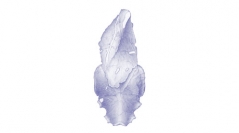

 Comptes Rendus Palevol
23 (6) - Pages 85-93
Comptes Rendus Palevol
23 (6) - Pages 85-93Understanding the origin and evolution of the unique mammalian respiratory system hinges on our knowledge of the osteological changes in the pectoral apparatus (i.e., scapulocoracoid, cleithrum, clavicle, interclavicle, sternum) throughout the synapsid fossil record. Among non-mammalian therapsids, documentation of this anatomy is woefully incomplete, with groups such as dinocephalians and gorgonopsians remaining poorly documented. Here we provide a detailed anatomical description of an articulated sternum and interclavicle of a well-preserved specimen of Aelurognathus tigriceps (Broom & Haughton, 1913) from the Lopingian upper Madumabisa Mudstone Formation, Luangwa Basin of Zambia. The sternal morphology reveals new anatomical details on the attachment sites for the ribs, showing three distinct facets, and a previously undescribed depression on the ventral surface for the attachment of the interclavicle. We also provide a preliminary discussion of the morphological variation of these elements both within Gorgonopsia and across Therapsida.
Sternum, Aelurognathus, Gorgonopsia, Zambia, Permian, Madumabisa Mudstone